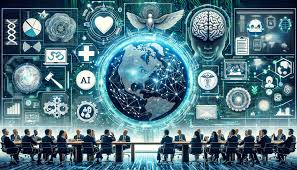Exploring The Technological Landscape of 2024: Python, AI, and the Future of Innovation
Introduction
As we move deeper into 2024, the technological landscape is rapidly evolving, bringing with it new opportunities and challenges. Central to this transformation are the fields of Python programming, Data Science, Artificial Intelligence (AI), Natural Language Processing (NLP), Generative AI, Prompt Engineering, Large Language Models (LLMs), and conversational AI platforms like ChatGPT. These technologies are not just buzzwords; they are the driving forces behind innovations that are reshaping industries and everyday life. This blog aims to explore these critical areas, offering insights into their significance, benefits, challenges, and the future they promise.
Overviews
Python: Python remains the most versatile and widely used programming language, essential for tasks ranging from web development to complex AI and data science projects.
Data Science: Data Science has become the backbone of decision-making in businesses, turning raw data into actionable insights that drive strategy and growth.
Artificial Intelligence (AI): AI has matured from experimental applications to being embedded in everything from healthcare to autonomous vehicles, making it a cornerstone of modern technology.
Natural Language Processing (NLP): NLP allows machines to understand and generate human language, making technology more accessible and interactive.
Generative AI: Generative AI is pushing the boundaries of creativity, enabling machines to create content, design products, and even innovate in scientific research.
Prompt Engineering: This emerging field focuses on optimizing the inputs given to AI models to produce more accurate and relevant outputs, becoming crucial in AI development.
Large Language Models (LLMs): LLMs like GPT-4 have set new standards in text generation, enabling applications that require understanding and producing human-like text.
ChatGPT: ChatGPT represents the cutting edge of conversational AI, offering highly interactive and personalized user experiences across various industries.
Importance
These technologies are not just advancing in isolation but are converging to create a more intelligent, efficient, and interconnected world. Their importance lies in their ability to automate complex tasks, enhance decision-making, and make technology more user-friendly. From improving healthcare outcomes to optimizing supply chains and creating personalized customer experiences, the impact of these technologies is vast and growing.
Python in 2024: The Ubiquitous Language of Technology
Python has long been hailed as the "language of the future," and in 2024, its prominence continues to grow. Its simplicity and versatility make it an essential tool for developers, data scientists, and AI researchers alike. Python's ecosystem has expanded, with new libraries and frameworks emerging to meet the ever-evolving demands of the tech industry.
In 2024, Python remains the backbone of most data-driven projects. Its integration with emerging technologies such as quantum computing and edge computing has further cemented its position as a must-know language. The Python community continues to thrive, contributing to the language's robustness and ensuring it remains at the forefront of technological innovation.
Data Science: Driving Insights in a Data-Saturated World
Data Science in 2024 is more critical than ever. As organizations continue to accumulate massive amounts of data, the ability to extract actionable insights has become a key competitive advantage. The role of data scientists has evolved from merely analyzing data to crafting predictive models that drive decision-making across industries.
Python, with its extensive suite of data analysis libraries like Pandas, NumPy, and the ever-evolving TensorFlow, remains the go-to language for data science. In 2024, the focus has shifted towards automating complex data processes and integrating machine learning models directly into business operations. Tools like AutoML (Automated Machine Learning) have become mainstream, allowing even non-experts to harness the power of data science.
Artificial Intelligence: From Concept to Ubiquity
Artificial Intelligence has moved beyond the experimental phase and is now an integral part of our daily lives. From healthcare to finance, AI is driving innovation and efficiency across sectors. In 2024, AI is no longer just a tool for solving complex problems; it is a strategic asset that organizations leverage to stay ahead in a competitive market.
Python's role in AI development remains unparalleled. The language's extensive library ecosystem, including TensorFlow, Keras, and PyTorch, allows developers to build sophisticated AI models with relative ease. AI's capability to learn, adapt, and optimize processes is continuously expanding, pushing the boundaries of what machines can achieve.
Natural Language Processing: Revolutionizing Human-Machine Interaction
Natural Language Processing (NLP) has seen significant advancements in 2024. The ability of machines to understand, interpret, and generate human language has opened up new avenues for innovation, particularly in customer service, content creation, and real-time translation.
Python’s NLP libraries, such as SpaCy and the Natural Language Toolkit (NLTK), have evolved to handle the growing complexity of language data. In 2024, the focus is on creating more nuanced and context-aware models that can understand not just the words but the intent and sentiment behind them. These advancements are making interactions with machines more natural and intuitive, bridging the gap between human and machine communication.
Generative AI: Creating New Realities
Generative AI continues to be one of the most exciting areas of AI research. In 2024, Generative AI is no longer limited to creating simple images or text. It now powers everything from video game design to drug discovery. The ability of AI to generate new, original content is transforming creative industries and scientific research alike.
Python's role in Generative AI is foundational. Libraries like GPT (Generative Pre-trained Transformer) have evolved, allowing developers to create models that can generate highly realistic and contextually relevant content. The ethical implications of Generative AI are also a major focus in 2024, as the technology's potential for misuse becomes more apparent.
Prompt Engineering: Crafting the Future of AI Interaction
Prompt Engineering has emerged as a critical skill in 2024. As AI models become more sophisticated, the quality of the input—known as the "prompt"—significantly influences the output. Effective prompt engineering allows developers to guide AI models toward producing the desired results, making it a key aspect of AI development.
Python continues to be the preferred language for prompt engineering, thanks to its flexibility and extensive support for AI development. In 2024, tools and frameworks specifically designed for prompt engineering have been developed, enabling more precise control over AI model behavior. This has become especially important in applications like AI-driven content generation and interactive AI systems like ChatGPT.
Large Language Models: The Giants of AI
Large Language Models (LLMs) have reached new heights in 2024. These models, which include the latest iterations of GPT, are capable of processing and generating human-like text with unprecedented accuracy and coherence. LLMs are now central to applications ranging from automated customer support to real-time language translation.
The scale and complexity of LLMs have continued to grow, requiring significant computational resources. Python remains the primary language for developing and deploying these models, supported by powerful libraries and frameworks. In 2024, the focus is on making LLMs more efficient and accessible, ensuring that their benefits can be realized across various industries without the need for extensive technical expertise.
ChatGPT and the Evolution of Conversational AI
ChatGPT, powered by advanced LLMs, represents the cutting edge of conversational AI in 2024. Its ability to engage in meaningful, context-aware conversations has made it a vital tool in customer service, education, and beyond. ChatGPT is not just a product; it’s a glimpse into the future of human-computer interaction.
In 2024, ChatGPT has evolved to offer more personalized and dynamic interactions. It is used in a wide range of applications, from virtual assistants to mental health support. The ongoing development of ChatGPT highlights the importance of ethical AI design, as developers work to ensure that these models are both useful and aligned with human values.
The Road Ahead: 2024 and Beyond
As we navigate through 2024, the fields of Python, Data Science, AI, and their related technologies continue to evolve at a breakneck pace. The convergence of these technologies is creating new opportunities and challenges, reshaping industries, and redefining what is possible.
Looking ahead, the focus will be on making these technologies more accessible, ethical, and integrated into everyday life. The skills required to navigate this landscape are also evolving, with a greater emphasis on interdisciplinary knowledge and the ability to adapt to rapid changes.
For developers, data scientists, and AI enthusiasts, the journey is just beginning. The future is rich with potential, and those who embrace these technologies will be at the forefront of innovation. In 2024, the only limit is our imagination.
Pros
- Efficiency: Automation of routine tasks and enhanced decision-making capabilities.
- Accessibility: Python and AI tools have become more user-friendly, enabling broader participation in tech development.
- Innovation: Generative AI and NLP are driving creativity and new forms of content generation.
- Scalability: LLMs and AI models can be scaled to handle massive data sets and complex tasks.
- Personalization: AI, particularly in applications like ChatGPT, allows for highly personalized user experiences.
Cons
- Complexity: The rapid pace of development can make it challenging to keep up with the latest technologies and best practices.
- Ethical Concerns: AI and generative models raise significant ethical issues, including bias, misinformation, and privacy concerns.
- Resource-Intensive: Training large AI models requires substantial computational resources, making it difficult for smaller organizations to compete.
- Dependence: Over-reliance on AI and automation can lead to a loss of critical human skills and judgment.
Summary
The technological landscape of 2024 is shaped by the integration of Python, Data Science, AI, NLP, Generative AI, and more. These technologies are driving innovation across industries, offering both unprecedented opportunities and significant challenges. While they enhance efficiency, accessibility, and personalization, they also introduce complexity, ethical dilemmas, and resource demands.
Conclusion
As we continue to advance in 2024, the convergence of Python, AI, and related technologies will further transform the way we live, work, and interact with the world around us. Embracing these innovations while addressing their challenges will be key to unlocking their full potential. For professionals and enthusiasts alike, staying informed and adaptable will be crucial in navigating this dynamic and rapidly evolving landscape.
Thank You
Thank you for taking the time to explore these exciting developments in technology with us. Whether you're a developer, data scientist, or simply curious about the future, we hope this blog has provided valuable insights into the trends shaping 2024 and beyond.










No comments:
Post a Comment